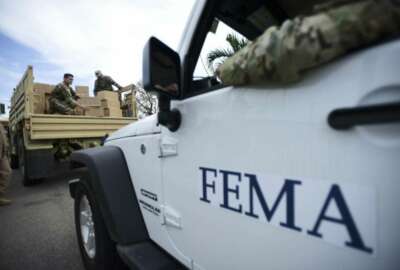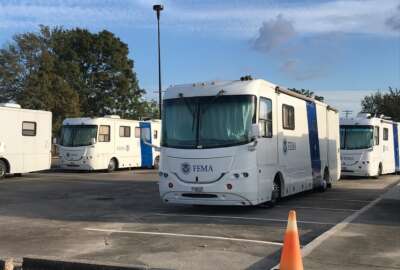
How can FEMA improve its work?
Many federal advisory boards continue to operate normally. One of them is the National Advisory Council supporting FEMA. Tom Temin spoke to acting director Rob ...
Best listening experience is on Chrome, Firefox or Safari. Subscribe to Federal Drive’s daily audio interviews on Apple Podcasts or PodcastOne.
The Pentagon might have cleaned house, but many federal advisory boards continue to operate normally. One of them is the National Advisory Council supporting FEMA, the Federal Emergency Management Agency. In fact, it recently came out with a long list of recommendations for the agency. With more, the acting director of the Council, Rob Long, joined Federal Drive with Tom Temin.
Interview transcript:
Tom Temin: Mr. Long, good to have you on.
Rob Long: Thank you, Tom. Glad to be on.
Tom Temin: And just to clarify, you are an employee of FEMA, and your assignment is overseeing the National Advisory Council, which is composed of people outside, correct?
Rob Long: That is correct. I’m the designated federal officer for the council.
Tom Temin: Okay, and just briefly describe how the council works and who some of the members are, the types of people that are qualified to join a council and advise FEMA.
Rob Long: Absolutely. The NAC membership is for three year terms. And we have those staggered and overlapping. So there are 35 members, and each year, we bring on about a dozen new folks. Those selections are made by the FEMA Administrator, and they’re vetted by the White House. They come on, we onboard them, they are members from all areas of emergency management and related professions. We have specialists in infrastructure and cybersecurity, we have tribal representatives, we have folks from local emergency management, and we have state administrators of emergency management that all come together on this council to give the best advice possible to the administrator. In fact, this month, we have a federal registry notice soliciting applications for potential members. So if you’re interested, you can find that at the federalregisterer.gov.
Tom Temin: And in normal circumstances does the council meet in person on a periodic basis?
Rob Long: Yes, our bylaws stipulate that we have at least two in person meetings each year. We typically have one in May, somewhere near DC so that we can have access to FEMA’s programmatic level staff that can come and kind of brief out on various things within FEMA. And then we have one later in the year, somewhere out in the United States, typically, we tried to do it somewhere near where there’s been a recent disaster so that we can try to get some firsthand information about what’s going on with that.
Tom Temin: Sure. And judging from the latest report of the council, I can see that you’ve been meeting virtually there’s a little tiled array of all the members meeting so you’re still able to meet, it’s just a virtual like everybody else.
Rob Long: We have to adapt to the times and we’ve had to bring in some new technology whiteboards. Obviously, Zoom is now a strong feature of everybody’s lives. And I would venture to say that the NAC members are about sick of their zoom calls. But we do get a lot done.
Tom Temin: Sure. I guess that’s pretty true of most of the world at this point, sick of it, but we got to soldier through it. And there was a report late last year to FEMA from the council. And it’s got a pretty long list of recommendations and concerns. And the first one was focus on equity and use equity as the foundation, programs are not targeted to those in greatest need. Tell us about that whole issue and what the council discussed and what they’re recommending.
Rob Long: Oh, absolutely. We have a lot of members on the council that have long been interested in equity, but that also merged with the former administrators interest in the subject. So for the prior two years, we had had one subcommittee known as the marginalized tribal, rural and small community subcommittee, that morphed into the equity subcommittee going into this next year, based on the charges given to us by the last administrator, we’re going to continue that work in equity. But you mentioned the 2020 report. And basically the 2020 report was an answer to administrator Gaynor, the former administrator who asked the NAC to provide a vision for emergency management in 2045. And as the 31 recommendations were being pulled together, they began to coalesce in a way that made it very clear that equity was the tentpole for this entire report. So as the report was being built, and the narrative arcs were being drawn, there were some other things, I mean, some obvious needs for improvement in coordination, data driven decision making, making sure that we’re looking at science, improving outcomes, but we kept coming back to equity. So again, the tent pole for the whole report was our outcomes need to be equitable, and that should be distinguished from being equal, right, being equal is just taking the pot of money and dividing it up equally to everybody. But that’s not what equity is, equity is making sure that everybody is on equal footing in the outcome. And so that’s what this report is about.
Tom Temin: Got it. And what have been some of the inequitable outcomes that maybe council members have observed in the past?
Rob Long: I think your audience is going to know that in this DC area what we end up having are legislation that needs to be translated into programmatic action. And the legislation doesn’t necessarily give a very clear picture of how that’s supposed to be accomplished and other times inadvertently put in restrictions, or otherwise you need to follow the legislation to the letter is what I’m trying to say. And in so doing, you can inadvertently cause side effects. Well, what the NAC members have observed is that over time in the application of programs, no specific program, just programs in general in the disaster context, that it can result in equitable outcomes. So the report needs to point out that in a quarter century, right, we have a long time to work on this. In a quarter century, then maybe we should line up the various things that need to happen in order to make sure that equitable outcomes are being achieved.
Tom Temin: And of course, 25 years is a long time. What does the council believe, what does FEMA believe, needs to happen to sustain that kind of effort over a period of multiple administrations and administrators of FEMA?
Rob Long: I’m going to go back to the prescient, that was built into PKEMRA (Post-Katrina Emergency Management Reform Act), which is the post Katrina law that had established this council. So this council has been going for 12 years now. And over the years, they have become increasingly good at understanding FEMA and FEMA of understanding the role of what we call the NAC, the advisory council in FEMA’S business. And in that partnership, over a dozen years, you’ve seen a coalescing of how the NAC can really be a forward thinking arm of FEMA in terms of looking at what issues are on the horizons and in what ways we can become better at helping people before, during and after disasters. So I think it’s the very existence of this council that will help bridge that gap to 25 years from now.
Tom Temin: And of course, it occurred, just right after the election, and then there was a transition process. Have you been able to share these findings, these reports, this 25 year look ahead with the transition teams, because there’s no new administrator yet for FEMA, but there’s going to be one arriving soon, we hope.
Rob Long: We hope so as well. I’ve not directly engaged with transition team, but the recommendations are easily found on the fema.gov website. And if your audience would like a shortcut, just go to a search engine and query FEMA NAC and that should take you right there.
Tom Temin: And what are some of the other top line recommendations you feel are particularly significant, especially as the workforce is going to have to carry these out over the time?
Rob Long: Well, as you can imagine that each of these recommendations are somebody’s baby and I don’t want to favor any one. But I will say that the theme of equity is just spot on. I mean, when you look at the values of FEMA, the core values being compassion, fairness, integrity and respect, you take those four values together, that’s equity plus, right. That’s what FEMA is all about. I mean, that’s why I came to FEMA. And I tell you, in emergency management, people are mission driven, and they live these values. So the recommendations were spot on in terms of the equity piece, and that being the focus of what we do in emergency management. I’ll give you a second one, I really think it’s a no brainer that we should be utilizing data. And so data, the recommendations regarding data driven decision making, I think, are also fantastic, and the direction we need to be going.
Tom Temin: And of course, there’s some practical things like creating a national supply chain strategy, better coordination up and down. That’s kind of a perennial, also in emergency management. Better use of mutual aid and shared resources. Those are also lessons I think, learned from Katrina and other disasters even earlier than that one.
Rob Long: Tom, you’re right. I mean, these are central things about FEMA. The last administrator had mentioned on many occasions that FEMA in many ways is a logistical agency. So anything that we can do to continually improve our ability to service our constituent community of emergency managers, we’re going to keep working on that there are continually after action reports. And again, the role of the NAC is to continually advise the administrator on these issues, and they come back to these, so we’re improving iteratively but steadily towards a better FEMA and better emergency management across the United States.
Tom Temin: Rob Long is acting director of the Office of the National Advisory Council for FEMA. Thanks so much for joining me.
Rob Long: Thank you Tom.
Copyright © 2024 Federal News Network. All rights reserved. This website is not intended for users located within the European Economic Area.
Tom Temin is host of the Federal Drive and has been providing insight on federal technology and management issues for more than 30 years.
Follow @tteminWFED
Related Stories





